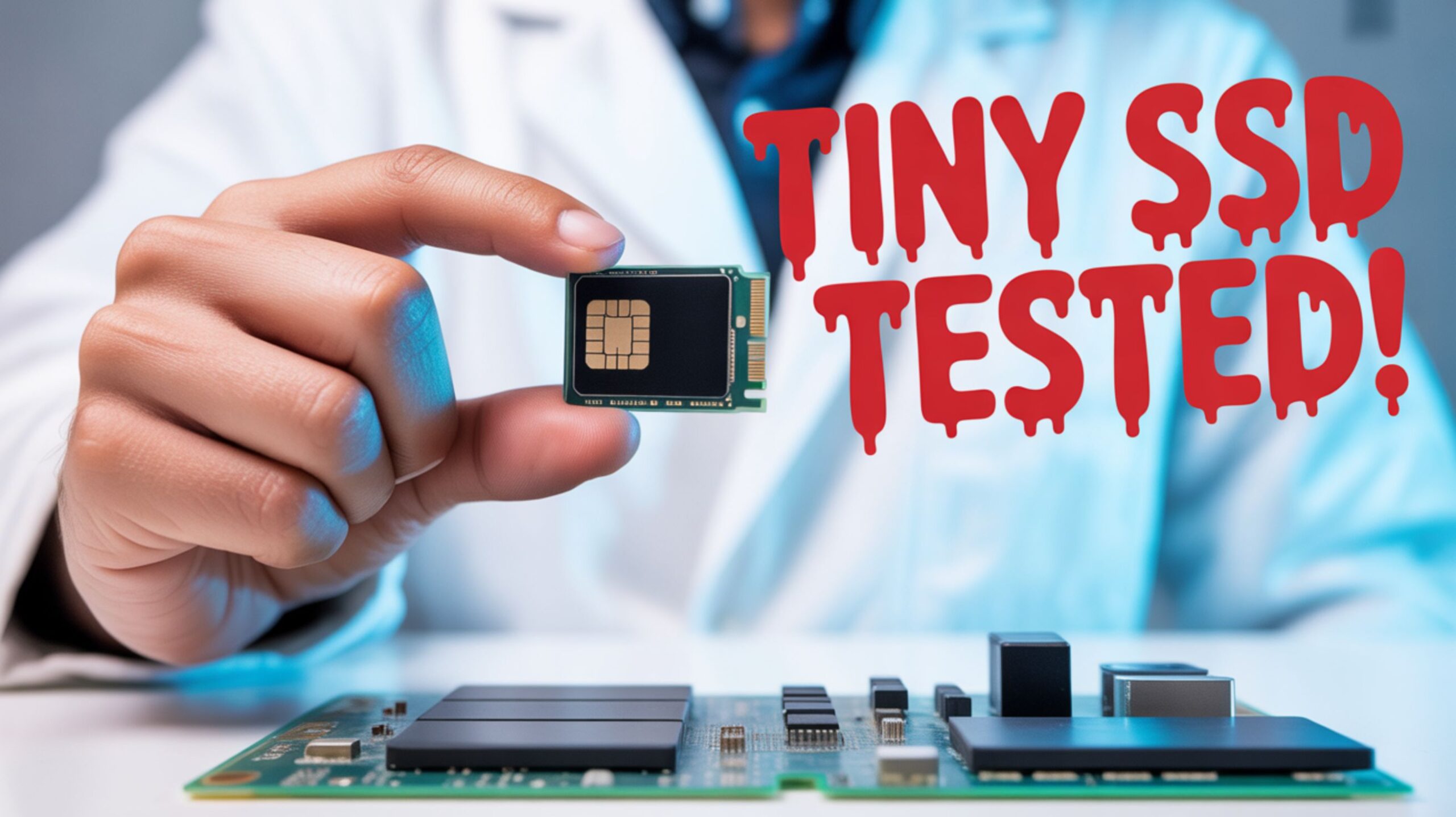China SIM Card–Sized SSD– The world of storage technology is undergoing a radical transformation, and one of the most intriguing developments is China’s new SIM card–sized SSD. Known as the Biwin Mini SSD or 1517 SSD, this ultra-compact storage device has already caught the attention of the tech community. But is it real, and what makes it so special? Let’s dive into the details of its features, performance, and potential impact on consumer electronics.
The Reality of the Mini SSD
Yes, the SIM card–sized SSD is very real. It was recently unveiled by Biwin, a Chinese storage manufacturer with strong ties to the gaming handheld and consumer electronics market. Unlike traditional SSDs or microSD cards, this Mini SSD has been designed for maximum performance in minimum space. It is already being integrated into next-generation handheld gaming devices in China, including the GPD Win 5 and OneXPlayer Super X.
Compact Design: SIM Card Form Factor
The biggest highlight of the Mini SSD is its tiny footprint. Measuring approximately 15mm × 17mm × 1.4mm, it is slightly larger than a microSD card and comparable to a SIM card. Unlike conventional M.2 drives, this SSD can be inserted into devices through a SIM tray–style slot, making it small, highly swappable, and convenient.
This miniature design allows laptops, smartphones, tablets, cameras, and handheld consoles to adopt high-speed storage without compromising internal space.
Performance That Redefines Portability
Despite its small size, the Mini SSD delivers remarkable speed. With support for PCIe 4.0 x2 lanes and the NVMe 1.4 protocol, it achieves:
- Sequential Read Speeds: Up to 3,700MB/s
- Sequential Write Speeds: Up to 3,400MB/s
To put this into perspective:
- It is several times faster than microSD Express, which maxes at around 985MB/s.
- It rivals full-size SD Express cards, which can theoretically hit 3,940MB/s.
- While it falls short of high-end M.2 NVMe SSDs that reach over 8,000–14,000MB/s, the Mini SSD delivers an optimal balance of speed and portability.
Storage Capacities and Options
Biwin’s Mini SSD comes in three storage variants:
- 512GB
- 1TB
- 2TB
This makes it suitable for everything from lightweight data storage to heavy-duty gaming libraries and 4K/8K video content. The 1TB and 2TB models will be game-changers for handheld gaming PCs, offering enough capacity to store large AAA titles without relying on slower microSD expansions.
Durability: Built for Extreme Conditions
Unlike delicate microSD cards, the Biwin Mini SSD has been engineered with durability in mind. According to official specifications:
- It has IP68 certification, meaning it is waterproof and dustproof.
- It can withstand drops of up to 3 meters, ensuring reliability during travel and outdoor use.
This makes it a viable option for gaming handhelds, professional cameras, rugged tablets, and industrial devices where storage reliability is crucial.
Thermal Management and Engineering
One of the concerns with ultra-small SSDs is heat dissipation. Biwin claims the Mini SSD features advanced thermal management technologies to ensure consistent performance. While detailed information about the cooling mechanisms is limited, reports suggest device manufacturers implement custom thermal solutions to prevent throttling during long gaming or video-editing sessions.
While the Mini SSD is revolutionary, its full integration potential will depend heavily on device design and engineering support.
Target Devices and Use Cases
The Mini SSD is not a universal replacement for existing storage standards—at least not yet. Instead, it is being targeted for niche but growing markets, including:
- Handheld gaming PCs like the GPD Win 5 and OneXPlayer Super X.
- Ultraportable laptops and tablets that need swappable high-speed storage.
- Smartphones are designed with expandable NVMe slots.
- Professional cameras and drones, where fast write speeds are crucial for high-resolution video capture.
The swappability of the Mini SSD makes it particularly attractive for users who want to carry multiple SSDs the way they currently carry microSD cards.
How It Compares to Other Storage Standards
Versus microSD / microSD Express
- Mini SSD: Up to 3,700MB/s
- microSD Express: 985MB/s theoretical maximum
- Verdict: Mini SSD is 3–4x faster while only slightly larger.
Versus SD Express
- Mini SSD: 3,700MB/s
- SD Express: ~3,940MB/s theoretical maximum
- Verdict: Comparable in performance, but the Mini SSD is smaller and swappable, making it more versatile.
Versus M.2 NVMe SSDs
- Mini SSD: 3,700MB/s max
- M.2 NVMe: 8,000–14,000MB/s
- Verdict: M.2 remains the performance leader, but Mini SSD wins in portability and flexibility.
Ecosystem and Compatibility Challenges
The most significant limitation of the Mini SSD is that it requires a dedicated slot format, not a standard SIM tray or microSD slot. This means widespread adoption depends on whether device manufacturers choose to support the technology.
Currently, only select Chinese handheld gaming PCs are offering this feature. Until more global brands adopt it, the Mini SSD will remain a specialised storage solution rather than a mainstream replacement.
Pricing and Availability
As of now, Biwin has not disclosed official pricing or global release details for the Mini SSD. Reports suggest it will remain exclusive to China’s handheld gaming market in the early stages. However, if successful, we can expect broader adoption and international sales shortly.
Given the high-performance benchmarks and rugged durability, the Mini SSD is unlikely to be priced as low as microSD cards. Instead, it will probably sit in the range of premium NVMe SSDs.
The Future of Ultra-Compact SSDs
The introduction of the Mini SSD marks a turning point in storage design. It blends the portability of microSD cards with the speed of NVMe SSDs, offering a unique middle ground for consumers.
If widely adopted, we could see a future where:
- Smartphones and laptops come with Mini SSD slots for expandable ultra-fast storage.
- Gamers swap game libraries between devices with ease.
- Content creators store and transfer 8K raw video footage without relying on bulky external drives.
The concept is innovative and practical, but its success will depend on ecosystem support, affordability, and real-world performance validation.
Wrap Up
The SIM card–sized SSD from Biwin is real, powerful, and potentially revolutionary. With blazing-fast PCIe 4.0 speeds, 2TB capacity options, and rugged durability, it promises to reshape how we think about portable storage. While it still faces compatibility and global adoption challenges, it represents a bold step forward in the evolution of compact SSD technology.
Adopted widely, this could become the new standard for swappable, ultra-fast storage in gaming devices, laptops, cameras, and beyond.

Selva Ganesh is a Computer Science Engineer, Android Developer, and Tech Enthusiast. As the Chief Editor of this blog, he brings over 10 years of experience in Android development and professional blogging. He has completed multiple courses under the Google News Initiative, enhancing his expertise in digital journalism and content accuracy. Selva also manages Android Infotech, a globally recognized platform known for its practical, solution-focused articles that help users resolve Android-related issues.




Leave a Reply